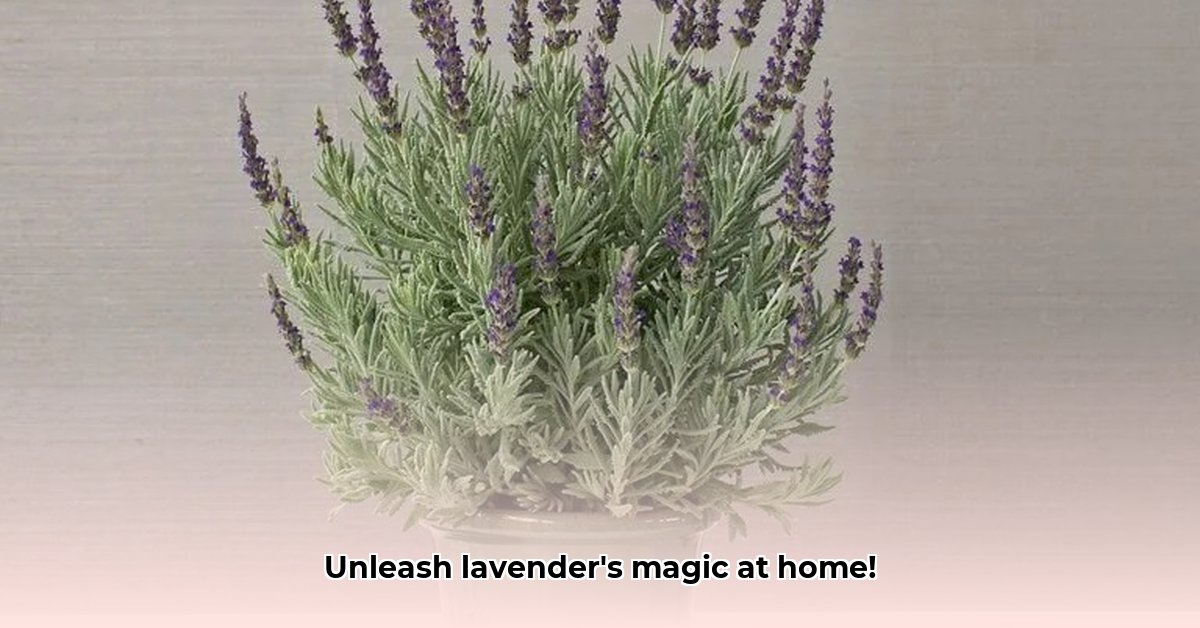
Imagine stepping into your home, greeted by the calming aroma of lavender, a scent synonymous with tranquility and relaxation. Growing lavender at home isn't just about aesthetics; it's about harnessing the plant's numerous benefits – from its soothing fragrance to its surprising culinary and crafting applications. This comprehensive guide will empower you to cultivate your own lavender haven, regardless of your gardening experience.
Choosing Your Lavender Variety: A Bouquet of Options
Before you begin, selecting the right lavender variety is crucial. Do you crave the classic English scent, or the more robust fragrance of French lavender? The choices are diverse, each with unique characteristics.
English lavender (Lavandula angustifolia), the quintessential lavender, thrives in cooler climates and offers a sweet, familiar scent ideal for culinary and aromatherapy uses. French lavender (Lavandula dentata), prefers warmer conditions and boasts a more intense, camphoraceous aroma.* Other varieties, like Spanish or Portuguese lavender, offer different flower colors, sizes and scents. Consider your climate and intended uses. A variety known for its abundant blooms might be perfect for crafting, while a culinary variety would be best for cooking. Research various types to find your perfect match. Don't be afraid to experiment with a few different kinds to see what thrives best in your environment!
Planting and Care: Nurturing Your Lavender
Now, let's get your lavender growing! Follow these steps for a flourishing plant.
Soil Preparation: Lavender demands well-draining soil. Amend heavy clay soil with sand or compost to improve drainage. Why? Because poor drainage leads to root rot, a common lavender killer.
Sunlight Requirements: Lavender craves sunshine! Aim for at least six hours of direct sunlight daily. A south-facing window is ideal for indoor cultivation. Insufficient sunlight will result in weak growth and fewer blossoms.
Planting: Dig a hole twice the size of the root ball. Gently place the plant, ensuring the top of the root ball is level with the ground. Backfill with soil, firming gently. Water thoroughly after planting.
Watering: Water deeply but infrequently, allowing the soil to dry somewhat between waterings. Overwatering is a major pitfall. Overwatering can lead to root rot, significantly impacting your plant’s health and longevity. Check the soil moisture before watering; if it feels moist, hold off.
Fertilizing: Lavender is not a heavy feeder. Excessive fertilization can be detrimental. A light application of balanced fertilizer in early spring may be beneficial, but it's not essential.
Propagation: You can propagate lavender from cuttings (taken in spring or summer) or seeds. Cuttings offer faster results, while seeds require more patience. Propagation allows you to expand your lavender collection and share the joy with friends!
Pest and Disease Control: A Natural Approach
Lavender is naturally pest-resistant, but occasional problems may occur. Here are some natural solutions:
- Aphids: Strong jets of water will often dislodge them.
- Spider mites: Improve air circulation around plants.
- Lavender Moth: Handpick visible larvae or consider a natural insecticidal soap. Successfully combating pests naturally provides a satisfying sense of accomplishment and keeps your garden ecosystem balanced.
Harvesting and Uses: Unleashing Lavender’s Versatility
Once your lavender blooms, you can begin harvesting. Harvest flower stalks when the buds are fully open but before they've fully bloomed. This yields optimal fragrance and essential oil content.
Aromatherapy: Create calming sachets by filling small fabric bags with dried lavender. Numerous studies suggest lavender's aromatic properties aid relaxation and sleep quality. Dried lavender also makes a beautiful potpourri.
Culinary Delights: Infuse lavender into sugar for baking, vinegars for dressings, or teas for a unique flavor (ensure you're using culinary-grade lavender). Lavender adds a delicate floral note to a wide range of dishes.
Crafting: Use dried lavender for homemade soaps, candles, or bath bombs.
Indoor Lavender Cultivation: Bringing the Outdoors In
While indoor lavender requires extra care, the rewards are worthwhile.
- Challenge: Reduced sunlight & air circulation.
- Solutions: Supplementary grow lights and adequate ventilation.
Economic and Environmental Benefits
Growing lavender offers economic and environmental advantages. You'll support pollinators, reduce reliance on commercially-produced products, and possibly even create a small business around your lavender-based creations. This sustainable approach aligns with eco-conscious practices and offers a fulfilling sense of self-sufficiency.
Conclusion: Embark on Your Lavender Journey
Growing lavender at home offers a multitude of benefits—aesthetic, aromatic, and practical. Its ease of care once established makes it a rewarding venture for gardeners of all skill levels. Embrace the journey of cultivating your own lavender haven, and savor the fragrant rewards!